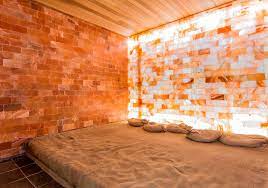In recent years, the concept of Himalayan salt houses has gained popularity as people seek alternative approaches to wellness and holistic living. These unique structures, built entirely or partially from blocks of Himalayan salt, are believed to offer a range of health benefits and create a tranquil environment. In this article, we’ll delve into the fascinating world of Himalayan salt houses, exploring their origins, the purported health advantages, and the aesthetic appeal that makes them an intriguing choice for those embracing natural living.
The Origins of Himalayan Salt Houses
Himalayan salt, renowned for its distinctive pink hue and mineral-rich composition, is sourced from the Khewra Salt Mine in the foothills of the Himalayan Mountains in Pakistan. The salt, formed millions of years ago from ancient sea deposits, contains trace minerals such as magnesium, potassium, and calcium, giving it a unique and purportedly therapeutic quality. The use of Himalayan salt in construction, particularly in the creation of salt houses, is inspired by the age-old practice of halotherapy, or salt therapy.
Halotherapy and Health Benefits
Respiratory Health: One of the primary claims associated with Himalayan salt houses is their potential to improve respiratory health. Proponents of halotherapy suggest that inhaling salt-infused air may help alleviate symptoms of respiratory conditions such as asthma, allergies, and bronchitis. The salt is believed to have anti-inflammatory properties that can soothe the respiratory system.
Balancing Ions: Himalayan salt is known for its ability to release negative ions when heated. Which proponents believe can counteract the positive ions emitted by electronic devices and other pollutants. This balance of ions is thought to create a more harmonious and stress-relieving environment.
Skin Conditions: Some individuals also turn to Himalayan salt houses for potential skin benefits. The minerals in the salt are believed to nourish and detoxify the skin. Providing relief for conditions such as eczema and psoriasis.
Architectural and Aesthetic Appeal
Salt Brick Construction: Himalayan salt houses are often constructed using large bricks or blocks of salt. Creating walls that emanate a soft, warm glow when illuminated. The translucent quality of the salt allows light to pass through, casting a calming and soothing ambiance within the space.
Customizable Designs: Himalayan salt houses come in various shapes and sizes, allowing for a high degree of customization. Some designs incorporate salt blocks into existing structures. While others are entirely built from salt. Creating a cocoon-like atmosphere that immerses inhabitants in the therapeutic benefits of the mineral.
Warmth and Texture: The natural color and texture of Himalayan salt contribute to the overall warmth and tactile appeal of these structures. The earthy tones and rough texture create a sensory-rich environment that contrasts with the sleek and sterile aesthetics of modern living spaces.
Cultural Significance
Himalayan salt has deep cultural significance, especially in regions where it is mined. In addition to its therapeutic uses, salt has been utilized in culinary traditions and various rituals. The incorporation of Himalayan salt into the construction of homes represents a nod to these cultural roots. Blending ancient practices with contemporary design principles.
Conclusion
Himalayan salt houses offer a unique fusion of health and aesthetics, drawing on the natural properties of Himalayan salt to create spaces. They are both visually striking and purportedly beneficial for well-being. The scientific evidence supporting the health claims of Himalayan salt house is still a subject of debate. The allure of these structures lies not only in their potential therapeutic benefits. But also in their ability to provide a tranquil and harmonious retreat. Whether viewed as a wellness sanctuary or an architectural marvel. Himalayan salt houses continue to captivate those seeking a holistic approach to living in harmony with nature.

